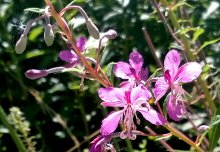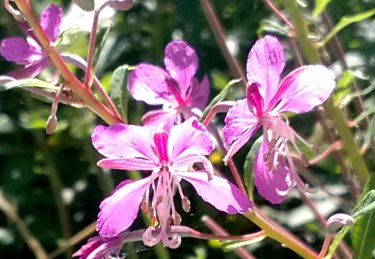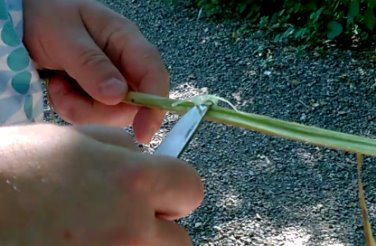Rosebay Willowherb
By Mike on Tuesday, July 26, 2016, 20:18 - Permalink

Rosebay Willowherb is a common plant of roadsides and riverbanks which has edible roots, stems and flowers.
What Is Rosebay Willowherb?
Chamerion angustifolium - also known as 'fireweed' and 'bombweed' on account of its tendency to appear on disturbed or scorched ground - this is a common plant, often seen in great patches along roadsides, path edges, river banks and wood edges.

It grows up to about two metres tall, producing a spike of pink flowers that open progressively over time - starting at the bottom end,
The leaves are long and slender and their arrangement on the stem is similar to that of some willow trees - which is where the plant get the 'willowherb' part of its name.

The individual flowers have four petals surrounding a protruding and intricate arrangement of stamens and stigma.
The flowers are edible - I nibbled one and it was mildly sweet and slighty fruity to taste.
They can be infused in hot water to make tea, and are sometimes made into jelly by steeping in water, straining, then boiling the resulting decoction with sugar and pectin.
The plant produces thick creeping roots which can be cooked and eaten.

It's the stems that probably of most immediate interest to the casual forager. They contain a moist, slightly stringy pith that can be scraped out and eaten raw.
The pith is distinctly sweet and sticky. I have heard it described as tasting like melon, but I think that's probably a little generous - there's a faint cucumber-like taste - not at all unpleasant.
Each stem only produces a fairly small amount of the sweet pith, so it would be quite an undertaking to make a proper meal of this plant, but it's an interestng wayside nibble and even on a hot and sunny day, the juicy pith is quite refreshing.

The flowers are followed by long, slender seed pods which eventually split open like bananas and release hundreds of tiny seeds embedded in clouds of wispy fluff - this can be gathered and used as tinder to assist in the lighting of fires.
I found and ate this plant whilst on a foraging walk along the Meon Valley Trail - along with a number of other interesting wild edibles - the video below details some of the things we found:
Note
Before, during or after the video(s) embedded in this page, the player may display advertisements or links to additional videos - these are not affiliated to Atomic Shrimp and the selection is something over which I have no control.
